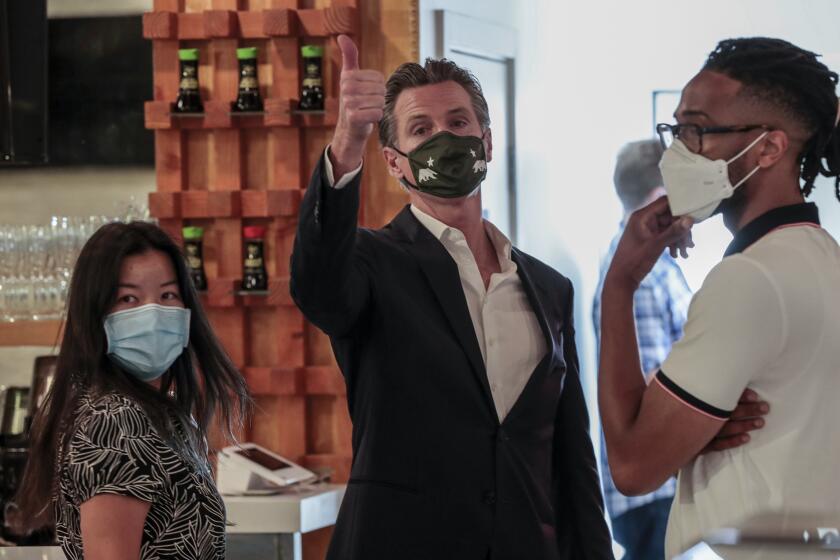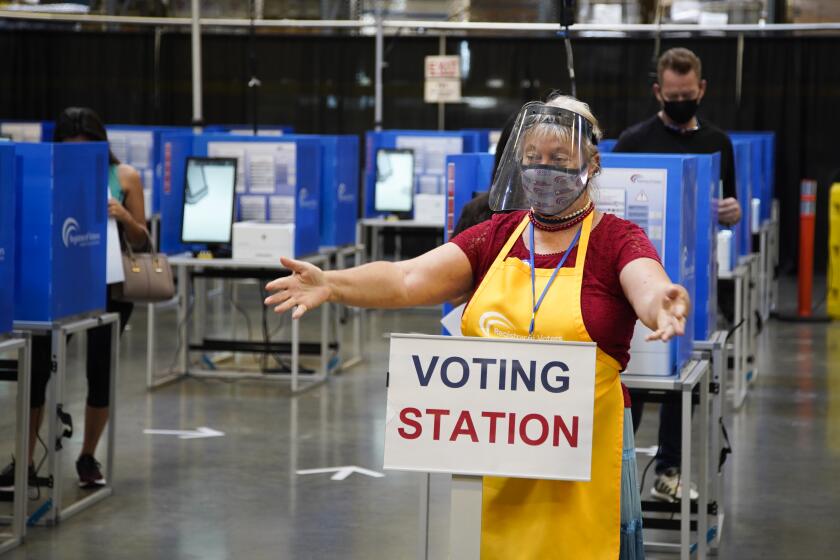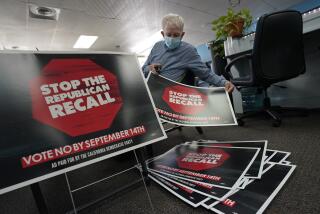Democrats push for speedy Newsom recall as new analysis pegs cost at $215 million

- Share via
SACRAMENTO — An analysis released Thursday projects the recall election against Gov. Gavin Newsom will cost at least $215 million, less than what elections officials initially estimated but a large enough price tag that local governments across California will need the state to pick up the tab.
Legislative leaders quickly seized on the estimate provided by the state Department of Finance as fulfilling a mandate under state law to fully assess the costs of the recall — potentially speeding up by some two months the special election in which voters could oust Newsom from office.
Senate President Pro Tem Toni Atkins (D-San Diego) and Assembly Speaker Anthony Rendon (D-Lakewood) said Thursday that they will include the projected cost in the state budget that must be enacted by the end of the month.
“By providing counties with the funding they need, we can waive the required period for the Joint Legislative Budget Committee to review the election costs,” the two leaders said in a joint written statement.
But it’s not clear when lawmakers would change the rules, a process led by legislative Democrats that could be seen as helping Newsom by forcing a recall election sooner rather than later.
The cost estimate came from an inquiry posed to counties by the Newsom administration in preparation for upcoming state budget negotiations.
“The total costs reported by all counties to conduct a special statewide recall election is $215 million,” state Department of Finance Director Keely Martin Bosler wrote in the Thursday letter to lawmakers. “This estimate does not reflect the Secretary of State’s costs associated with a statewide recall election.”
The bulk of the costs for the election would be incurred on the local level, where elections are conducted. State costs are generally much smaller. A spokesperson for Secretary of State Shirley Weber said there was no immediate comment on what other expenses might be expected.
Critics of Newsom submitted more than enough voter signatures this spring to trigger a recall election, setting the stage for only the second gubernatorial recall in California history. Then-Gov. Gray Davis lost a 2003 recall, replaced by Republican Gov. Arnold Schwarzenegger. So far, almost six dozen Californians have filed statements of intention seeking to run in the recall election — including former San Diego Mayor Kevin Faulconer, 2018 gubernatorial hopeful John Cox and reality TV star and retired Olympic decathlete Caitlyn Jenner, all Republicans.
No prominent Democrats have joined the preliminary field. Candidates can’t formally join the race until after an election date is chosen by Lt. Gov. Eleni Kounalakis.
Orrin Heatlie, a retired Northern California sheriff’s deputy and the official proponent of the recall, dismissed concerns about the election’s cost and accused Newsom of pandering to voters to boost his chances of political survival, citing the governor’s proposals to provide new economic stimulus payments and cash prizes for those who get COVID-19 vaccinations.
“With the billions this governor is handing out in recall rebates and game-show antics, the cost of the election is a small investment in the future of the state,” Heatlie said.
A poll by UC Berkeley’s Institute of Governmental Studies that was co-sponsored by The Times and released last month found only 36% of registered voters surveyed would remove Newsom from office.
Democratic voters in a new poll also overwhelmingly favored having a prominent Democratic replacement candidate on the recall ballot in case Newsom was ousted from office.
An exact date for the recall election has remained elusive because of differing viewpoints about the meaning of a 2017 law that revamped the recall process. That statute was written by Democrats in hopes of delaying a recall election against state Sen. Josh Newman (D-Fullerton) long enough to consolidate it with the 2018 statewide primary. Though they succeeded in delaying the election, voters in Newman’s Orange County district recalled him anyway, changing course and reelecting him to a new term in office last November.
The 2017 law added up to 90 days to the preparations for a recall election — time for voters who signed the petition to change their minds and for state officials to calculate the cost to conduct the election. The deadline for voters to remove their signatures was Tuesday and now elections officials in the state’s 58 counties have until June 22 to send information about those changes to Weber.
But the two required fiscal analyses — one by the state Department of Finance, the other by the Joint Legislative Budget Committee — are described differently in the law. Under the interpretation now embraced by Atkins and Rendon, it’s possible the Newsom recall could be held before the end of the summer.
Legislative staff members say a change to the 2017 recall law that expedites the fiscal analysis will be inserted into a state budget-related bill as soon as next week.
The survey of California counties unsurprisingly found most of the costs for conducting a recall election would come from the state’s urban centers — with Los Angeles County estimating expenses of $49.1 million, San Bernardino County pegging its costs at $32 million and San Diego County reporting an estimate of $20 million. Alameda County’s estimate of almost $21 million in recall election costs was the highest of any county in Northern California.
In April, elections officials across the state painted a more dire picture, offering a preliminary estimate of $400 million. That number, they said, was based on the costs incurred in the 2020 election cycle. Donna Johnston, Sutter County’s registrar of voters and president of the state association of elections officers, said that projection included some elements of last fall’s election — including costs related to pandemic protections — that might not be applicable under current conditions.
A special statewide election this fall where voters could remove Gov. Gavin Newsom from office could cost $400 million to conduct, elections officials estimate.
Neither effort to crunch the numbers should be considered complete. A large number of candidates running to replace Newsom, for example, can lead to multipage ballots and voter guides, adding on additional expenses. In 2003, for example, there were 135 candidates on the ballot seeking to replace Davis.
Other unknowns, including whether the ballot will include additional contests and what that will do to the cost of mailing ballots and other materials, are unlikely to be cleared up any time soon.
“There is much that has been and remains fluid about the recall,” said Dean Logan, the registrar of voters in Los Angeles County.
It’s also uncertain what kinds of in-person regulations might be adopted by the Legislature for the recall if COVID-19 conditions should worsen. The pandemic prompted lawmakers earlier this year to extend last year’s temporary rules requiring elections officials to mail a ballot in the recall election to all of California’s 21 million voters.
Heatlie disputed the need for that accommodation. “With the state reopening this month, there is no need for an all mail-in ballot system,” he said. “We could and should return to in-person voting as we’ve had in the past.”
Kim Alexander, president of the nonpartisan California Voter Foundation, praised lawmakers for promising that there will besufficient funding to cover the expenses.
“County election departments have been hit hard by staff losses, budget cuts and an uptick in harassment and personal attacks,” she said. “This funding will give them peace of mind that they will have adequate resources to carry out their responsibilities.”
Times staff writer Phil Willon contributed to this story.
More to Read
Sign up for Essential California
The most important California stories and recommendations in your inbox every morning.
You may occasionally receive promotional content from the Los Angeles Times.













